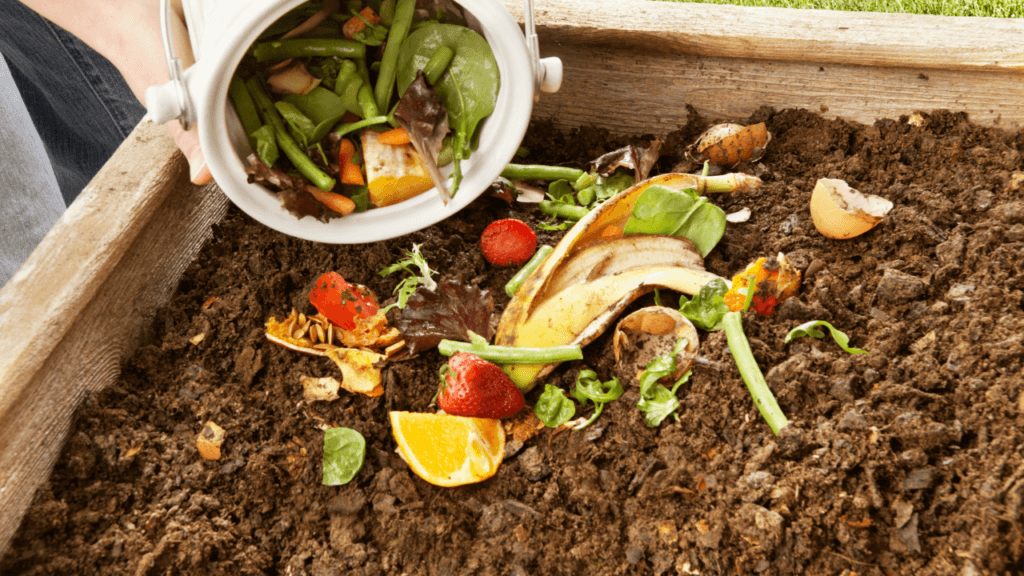This post may contain affiliate links, meaning I may receive a commission from purchases made through links. Learn more on my privacy policy page and disclaimer page
Are you looking for a sustainable way to transform kitchen scraps into something valuable? Look no further than composting. In this article, we’ll explore the ins and outs of composting, how it can benefit your garden, and how you can quickly get started in your backyard.
Composting is a natural process that converts organic waste, such as kitchen scraps, into nutrient-rich soil, known as compost. Creating a compost heap can turn these seemingly worthless scraps into “black gold” that will nourish your plants and promote a healthier, more sustainable garden.
Composting offers a range of benefits beyond just reducing waste. The compost you produce is a sustainable source of nutrients for your plants, enhancing their growth and overall health. It also improves the structure of the soil, making it easier for roots to penetrate and access vital nutrients.
Now, let’s look at why composting is so good for your plants and how you can start composting at home.
Key Takeaways:
- Composting transforms kitchen scraps into nutrient-rich soil, known as compost.
- Compost improves plant growth, soil structure, and overall garden health.
- Composting at home is simple and requires a compost bin and the right balance of compostable materials.
- Maintaining and harvesting the compost heap can be done with regular maintenance and proper techniques.
- Composting reduces waste, provides sustainable nutrients, and promotes a greener future.
Why Composting Is Good for Plants
Composting is like a superfood for plants. It has numerous benefits that contribute to your garden’s overall health and vitality. Let’s explore why composting is so beneficial for plants.
Improves Soil Structure
One of the critical advantages of composting is its ability to improve soil structure. Adding compost to your garden enhances the soil’s texture, making it looser and more porous. This improved soil structure allows for better water drainage and root penetration, creating an ideal environment for plants to thrive.
Enhances Nutrient Uptake
Compost is a rich source of nutrients that are essential for plant growth. Incorporating compost into the soil gradually releases these nutrients, ensuring a steady supply for your plants. Unlike synthetic fertilizers, which provide a quick burst of nutrients that can be easily washed away, compost nourishes plants over an extended period, leading to improved nutrient uptake and long-term plant health.
Fosters Beneficial Microorganisms
Composting introduces beneficial microorganisms, such as bacteria and worms, into the soil. These microorganisms play a crucial role in breaking down organic matter and releasing nutrients in a form that plants can readily absorb. They also help create a healthy soil ecosystem by improving soil fertility and suppressing harmful pathogens.
Promotes Sustainability
By composting, you actively contribute to sustainability efforts. Composting reduces the need for synthetic fertilizers and pesticides, which can harm the environment. It also diverts organic waste from landfills, reducing methane emissions and conserving valuable landfill space. By embracing composting, you become part of a sustainable gardening movement that promotes a healthier planet.
Composting truly is a win-win solution for both your plants and the environment. It enhances the soil structure, improves nutrient uptake, fosters beneficial microorganisms, and contributes to sustainability. Embrace composting and watch your garden thrive!
How to Start Composting at Home
Starting composting at home is an easy and rewarding endeavor that anyone can undertake. There are various options, but the first step is to select a compost bin that suits your space and lifestyle. You can find one that fits your needs, if it’s a purchased bin or a DIY project using aer.
Once you have your compost bin, knowing what materials are compostable and what to avoid is important. Compostable materials include fruit and vegetable scraps, coffee grounds, yard trimmings, and shredded paper. However, avoiding composting meat, dairy products, and plastics is crucial, as they can disrupt the composting process and attract pests.
Creating the right balance of “green” and “brown” materials is essential for a healthy compost pile. “Green” materials refer to nitrogen-rich items like kitchen scraps and grass clippings, while “brown” materials like dry leaves and shredded paper are carbon-rich. By layering these materials and keeping them moist, you’ll ensure a well-balanced compost pile that breaks down efficiently.
Maintaining your compost pile requires regular turning to introduce oxygen and aid decomposition. It’s also essential to monitor the moisture levels and add water if necessary. Proper maintenance will expedite the process, and your compost will be ready in a few months.
Once your compost has undergone decomposition and has a dark, crumbly texture, it is ready to be harvested. Gently remove any non-composted materials and use the finished compost to enrich your garden soil, providing essential nutrients and improving quality.
FAQ
What is composting?
Composting is a natural process that transforms everyday waste into a nutrient-rich soil enhancer called compost. It involves decomposing organic material such as kitchen scraps, leaves, grass clippings, and coffee grounds.
Why is composting good for plants?
Composting is like a superfood for plants. It improves soil structure, provides essential nutrients, releases nutrients slowly over time, and introduces beneficial microorganisms into the soil.
How do I start composting at home?
Starting composting at home is simple. You can choose a compost bin that suits your space and lifestyle, know what materials are compostable, balance “green” and “brown” materials, regularly turn the compost, and maintain proper moisture levels.





